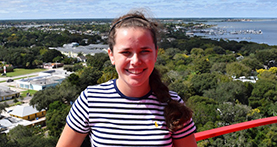By Katie Garwood | gargoyle@flagler.edu
“So, who wants to shovel the coquina into the hyena cage?”
“Wait, what?” But before I could even comprehend the question, my roommate already had volunteered us to complete this seemingly innocuous task.
The two of us, along with about 15 other students and faculty members had been bused out to the St. Augustine Wild Reserve as part of Flagler’s inaugural “Reach Out Raise Up” day of community service.
Before the day began, I expected an easy, laid-back day, filled with completing menial tasks that the organizations could trust college kids with. Before we even arrived at the reserve, the site leader handed me a waiver to sign. I thought I was there to help people, not sign my life away.
After being volunteered for a task I knew nothing about, I was led into the wildlife reserve through chain-link gates with warning signs, one of them announcing the presence of an “attack turkey” that roamed the area.
Before I knew it, my team and I were hard at work shoveling coquina rock into a wheelbarrow, then dragging it over to the hyena cage. If I wanted the easy way out of volunteering, I was going the wrong way.
We pulled the wheelbarrow through wet, thick mud into the hyena cage. I tried to avoid getting my shoes dirty as we trudged through the mud, which proved to be futile. After a short time, my shoes were caked with mud.
We stepped into the hyena cage, where we began shoveling the coquina, repeatedly pulling the wheelbarrow through the mud to refill it and then bring it back to the cage to continue shoveling. After we finished, we wheeled a large tub into the enclosure in which the hyenas would later take a bubble bath.
The reserve is home to exotic animals that were either rescued or confiscated from unfit owners. The reserve’s goal is to educate people about exotic animal ownership and how the wild animals usually don’t fit into everyday life or households. Animals at the reserve include lions, bears, ligers, wolves, deer and tigers, which was the next animal we were assigned to help.
We were led farther back into the reserve, and as we walked, we passed by African Geese who roam the property, a three-legged black panther exhibit and a Golden Tabby Tiger, which is one of 30 in existence in the world.
We arrived at the tiger exhibit, where we would be filling muddy areas with coquina rock to enable the tiger, who doesn’t like getting his paws muddy (which I understood by this point as I looked at my shoes), to cross into the other area of his enclosure. Before we began, the woman in charge of our group gave us two rules: Don’t turn your back on the tiger cage, and don’t touch the tiger cage. Seemed simple enough. What idiot would touch the tiger cage?
We again shoveled coquina into the wheelbarrow and dragged it through thick mud, which I didn’t even try to avoid this time, considering my shoes were already past the point of no return.
The wheelbarrow was finally brought into the back area of the tiger cage, where it was unloaded and spread out. This was our last task of the day, and we all felt pretty accomplished. I pulled the empty wheelbarrow out of the cage and felt myself starting to sink into some mud. I put my hand on the cold, metal bar to steady myself and turned to get out of the mud. In that moment, I suddenly remembered the two rules I was given before we started and realized that I not only had my hand on the tiger cage, but I had my back to the big cat’s cage. The tiger pounced to the fence where I stood on the other side, hand on the cage. I jumped back, just in time to keep my hand.
So, in case you were wondering what idiot would touch the tiger cage, that idiot is me.
At the start of the day, I envisioned myself scrubbing food bowls indoors, maybe getting a chance to pet an animal and going home as if nothing ever happened. What I ended up with were muddy shoes and clothes, a greater appreciation for rules and somehow, a desire to help more. I left wishing I could have stayed all day helping with the animals, because I saw that the Flagler service team actually had made a difference. We not only helped the animals, but the people who dedicated their lives to giving these animals a safe place to live.
As much as I wanted to take the easy way out of volunteering, and signing up for the day of service just for the co-curricular event credit, I am glad I didn’t. Because if I did, I wouldn’t have worked as hard as I did, and would have gotten nothing out of the day of service. And why do anything if you’re not going to get anything out of it?



Be the first to comment on "Volunteering in the wild — sort of"